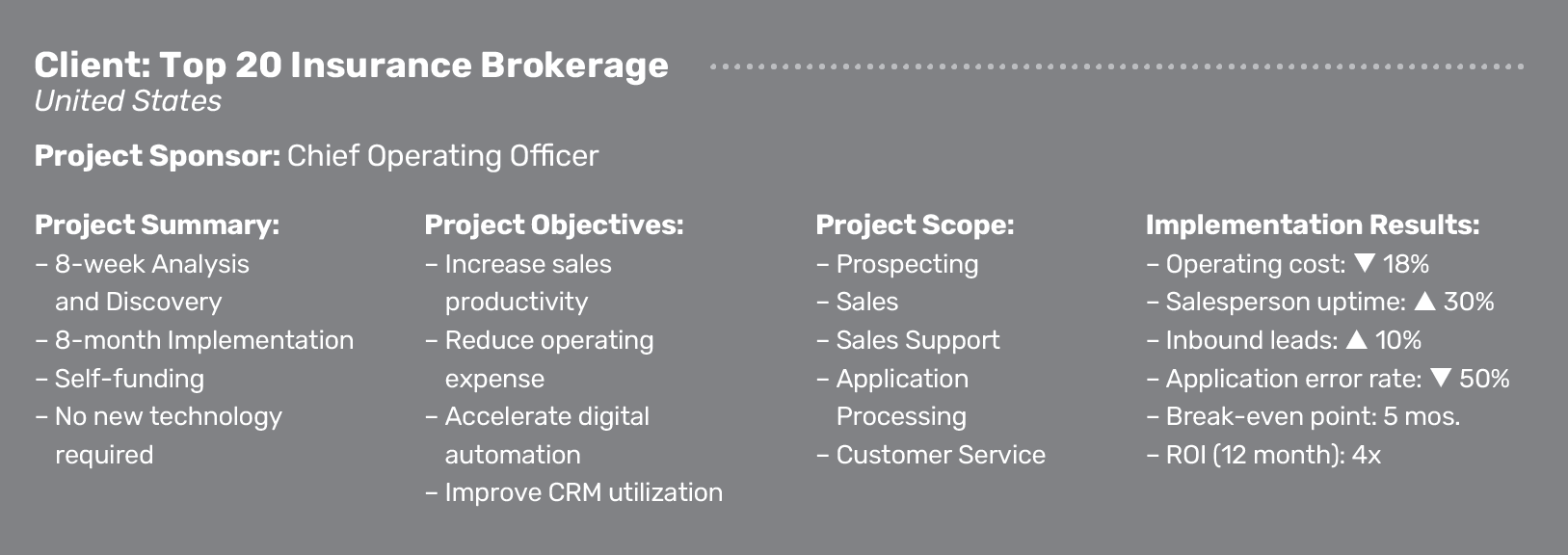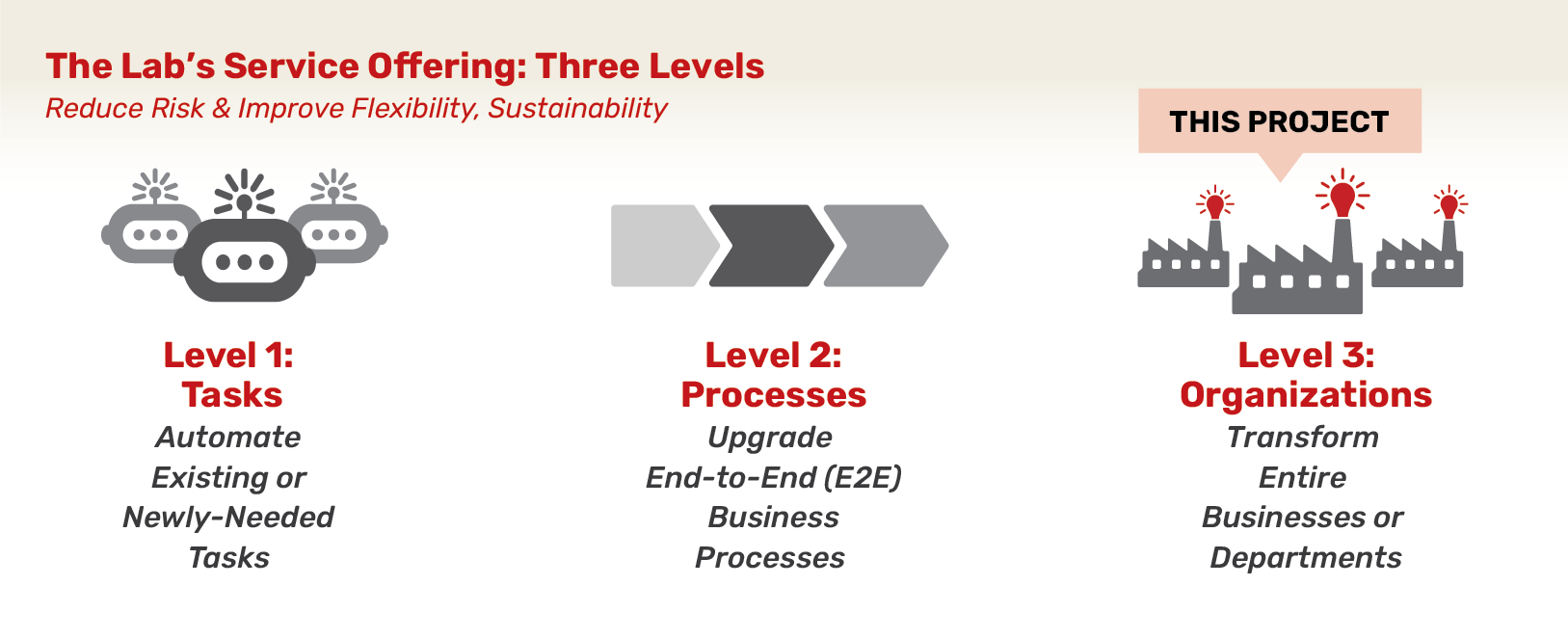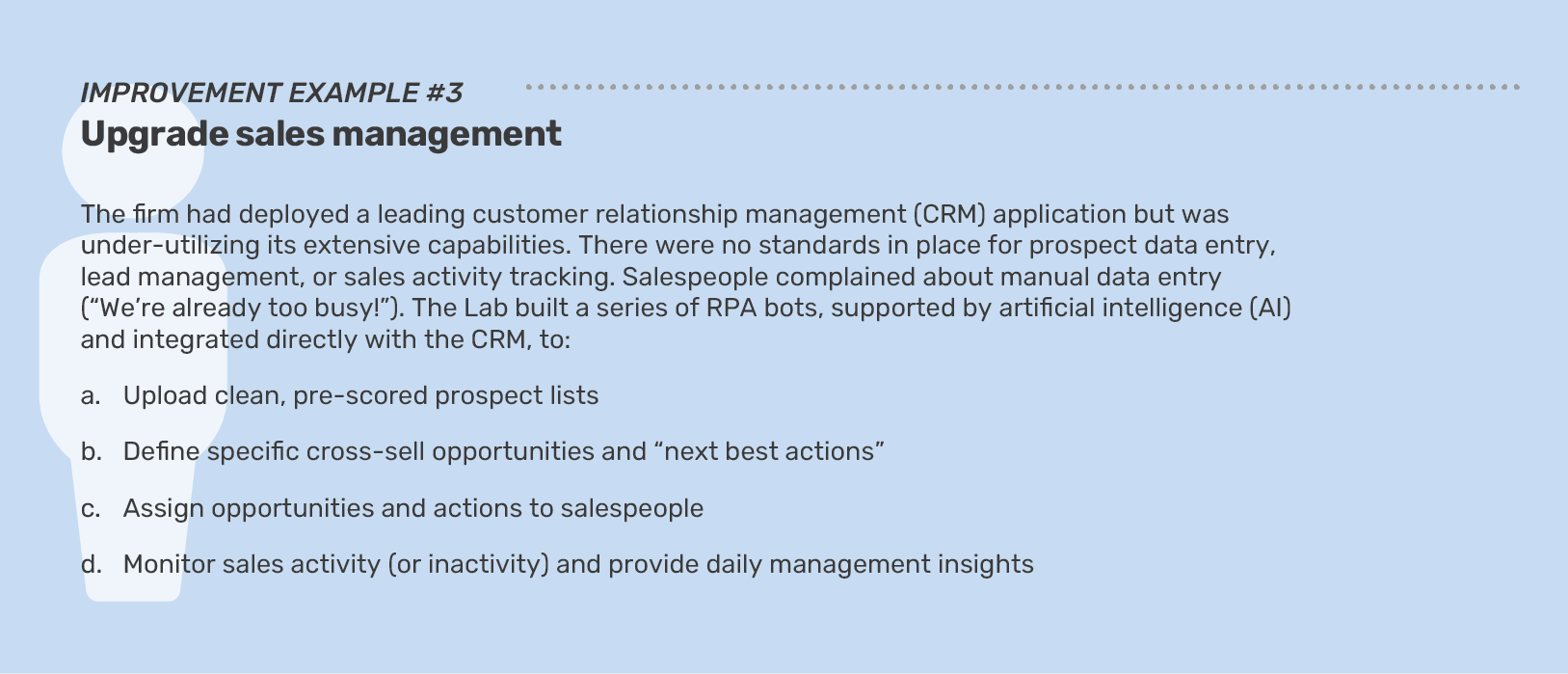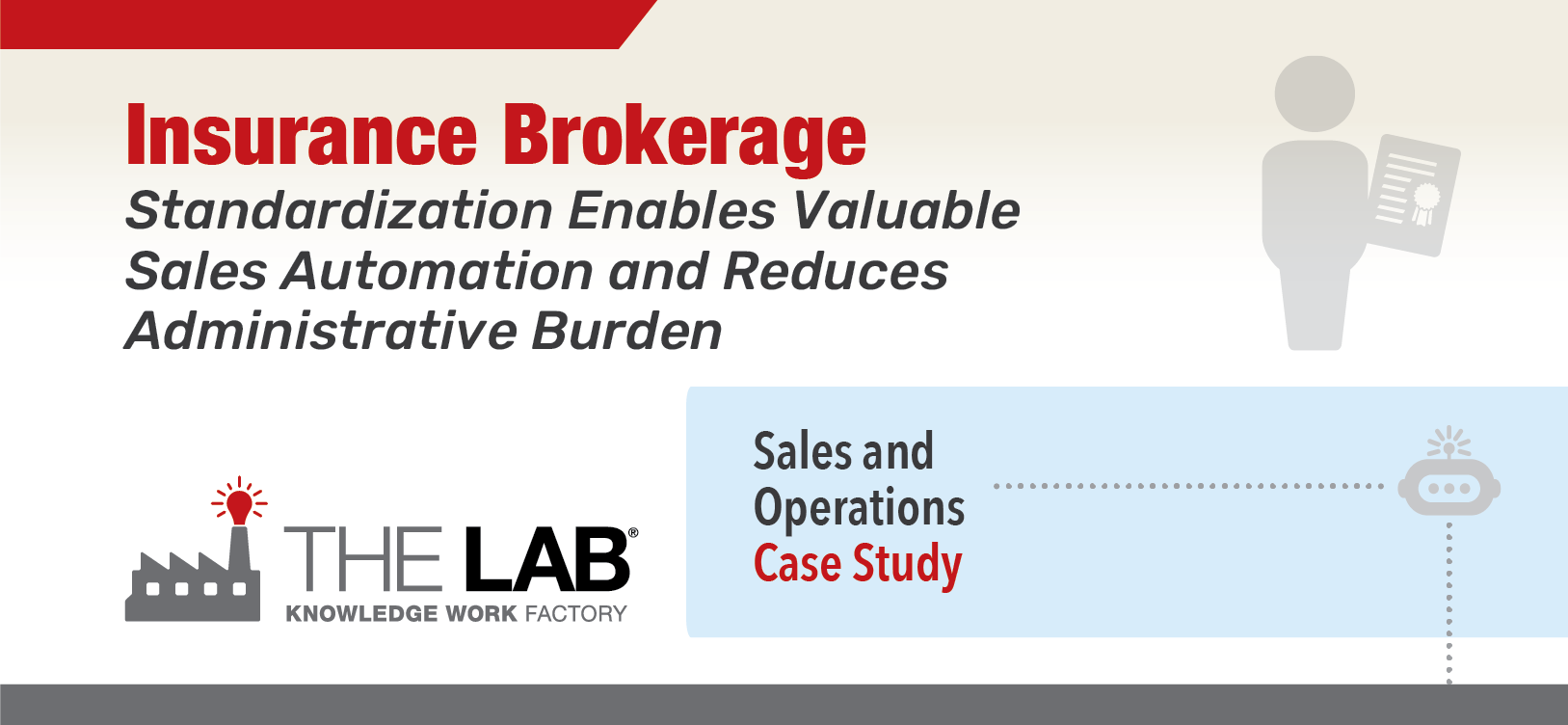Sales and Operations
The recently-hired COO of a large, successful, third-generation, family-controlled insurance brokerage struggled with a range of frustrating challenges. The traditional, “sales-driven” culture typical of almost all comparable brokerages was based heavily on personal, face-to-face relationships. Lots of businesses rely on this model for sales; however, this culture also pervaded senior management’s views regarding technology adoption and operational improvement.
Challenges to the face-to-face mode of doing business seemed to grow larger with every passing year—even for the sales team. The COO understood the essential role of personal, “manual” effort in client sales and service interaction.
However, beyond those high-touch work activities, she could see that the brokerage’s culture of loosely standardized business processes, rife with corrections and manual workarounds, was squandering costly resources. Even worse, the lack of standardization limited automation and the operational capabilities critical to success in the current volatile markets: speed, flexibility, and resilience.
As an “outsider” with a well-rounded resume, the COO was startled at the outdated operational capabilities of the insurance broker segment overall. The issues were pervasive, stretching from the most critical tasks (sales prospecting) to the most mundane (endorsements). She was particularly concerned with the unsophisticated state of the firm’s technology planning, which seemed continually focused on the next big systems upgrade. Its effort at installing digital automation—specifically robotic process automation (RPA) and artificial intelligence (AI)—was stalled.
She was fully aware that the current, unstructured “maverick” sales-prospecting and management approach had built the company and enabled acquisitions of smaller firms. But she believed that more disciplined, more digital capabilities needed to be added. Otherwise, organic growth was likely to lag, and the firm could quickly find itself an acquisition target, rather than its traditional role of acquirer.
The COO knew she had a difficult internal sales job ahead with existing management and the family owners. She contacted The Lab, having previously worked with The Lab on a successful
large-scale transformation engagement at another company.

Client Description, Project Scope, Objectives
The insurance brokerage ranked in the U.S. top 20. Within half of its regional markets, it consistently maintained a leadership position based on market share (typically in the top five). The scope of the effort was enterprise-wide, documenting over 85 percent of the activity-level work for all 900 employees and affiliates. The objective of Phase I was to design an implementation work plan to quickly free up existing capacity by eliminating wasted effort, while restarting the stalled digital automation initiative and retargeting it toward high payback opportunities (use cases).
Phase I, Analysis and Discovery
The insurance brokerage sales and operations standardization initiative began with an eight-week Phase I analysis covering several key, end-to-end business processes, including:

The Lab’s database of insurance brokerage templates—including industry-standard KPIs, process maps, benchmarks, best practices, automation “use cases,” and more—enabled rapid documentation and analysis of more than 85 percent of employee work activities (approximately two minutes each), while only requiring one hour per week of any subject matter expert’s (SME’s) time.
During the Phase I analytical effort, The Lab identified over 150 activity-level improvements. Just over 50 percent of these represented non-technology standardization improvements that boosted sales effectiveness, reduced avoidable rework, and/or enabled automation. While the remaining improvements were technology-dependent, no new systems were required. Roughly half could be automated using the existing technology after the work was standardized. The remainder were automated using robotic process automation (RPA), sometimes augmented with artificial intelligence (AI) for simple decision making.
Better yet, all improvements could be implemented in eight months or less, with benefits beginning to accrue from standardization within six weeks of the start of implementation.
Phase I findings
The marketplace was becoming increasingly volatile and fast-paced. Digital automation would deliver operating flexibility to weather both upside and downside more profitably. But the organization had simply shrugged off earlier efforts at piloting these technologies.
However, after reviewing The Lab’s detailed business-process maps and improvement “inventories,” even the strongest advocates of face-to-face sales and service were stunned at the scope of the inefficiencies that squandered valuable opportunity. Performance for identical sales activities—both efficiency and effectiveness—varied by 3x to over 20x. There we no mechanisms to identify, record, and share best practices that would narrow these costly gaps.
Salespeople spent most of each day performing ad hoc administrative tasks rather than prospecting, cross-selling,
or training new recruits. Although admin specialists could perform these activities, there were no plans or methods
to hand off or automate this highly repetitive, error-prone work to RPA bots or existing systems.

Phase II, Implementation
The eight-month, self-funding Phase II implementation effort was able to simultaneously increase sales effectiveness, reduce sales downtime, upgrade customer experience, and deliver cost reduction.
Implementation improvement goals were established for each organizational area. Senior management could perform the work with any mix of resources they chose: internal resources, The Lab’s resources, or others. The Lab maintains a three-tiered service-offering structure (plus ongoing post-implementation support) to make this as flexible and sustainable as possible for clients:

Post-Implementation Support, Sustainability & Automation
The Lab provided hassle-free post-implementation hourly sustainability support for this client to maintain automations, process standardization, and operational data analytics models implemented during the Phase II engagement. If the client’s team was not up-skilled enough to perform any needed automation updates, they leaned on The Lab for Tier 3-level support. If analytics dashboards required additional views or data connected, The Lab’s team was a simple phone call away.
Improvement Examples, Service and Distribution Standardization
The Lab consolidated the 150 improvements into a self-funding implementation work plan. Examples:



The Lab Makes it Easy
Organization-friendly engagement design
At The Lab, we’ve spent three decades refining every aspect of our transformation engagement model. We’ve made it easy for clients—from the C-Suite to the front line—to understand and manage the initiative:
• Minimal use of client time: One to two hours each week, maximum.
• Measurable benefits: Typical 12-month ROI is 3x to 5x.
• Pre-built templates and tools: Process maps, data models, bots, and more.
• U.S.-based, remote delivery: Nothing is ever outsourced or offshored.
Designed to reduce risk, increase success
Since 1993, The Lab has led the industry in eliminating risk for our clients. Whether your engagement involves a handful of bots or wall-to-wall transformation, we make it easy to do business with us:
• Fixed pricing and clearly defined scope
• Pre-project feasibility/value assessments at nominal cost
• Early-out checkpoints and options
• Money-back guarantees
Book your free demo
The best way to learn about The Lab’s patented Knowledge Work Standardization® approach is to book your free, no-obligation 30-minute screen-sharing demo. And you’ll get all your questions answered by our friendly experts. Simply call (201) 526-1200 or email info@thelabconsulting.com to book your demo today!
















